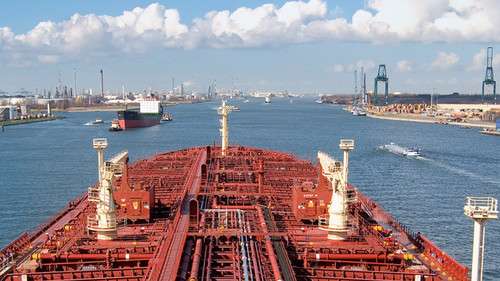Evonik invests in innovative methionine source for shrimp
Essen. Evonik Industries will build the world's first plant for the production of AQUAVI® Met-Met—a new source of methionine specially developed for shrimp and other crustaceans—in Antwerp (Belgium). AQUAVI® Met-Met is added to the feed used in aquacultures. The plant is scheduled to commence operation in late 2015. The investment volume is in the lower double-digit-million-euro range.
Evonik Executive Board member and Chief Operating Officer Patrik Wohlhauser: “AQUAVI® Met-Met is an ideal addition to our product portfolio for aquacultures and opens up new growth perspectives for Evonik. It strengthens our position as the leading supplier of feed additive amino acids for animal nutrition." The product is protected by a number of IP laws worldwide, including an application patent.
“We will initially offer AQUAVI® Met-Met for use with shrimp and crustaceans. Use with other species will follow," says Dr. Reiner Beste, Head of Evonik's Health & Nutrition Business Unit. The new plant is set up in such a way that we will be able to provide our customers with a reliable supply of AQUAVI® Met-Met in the future.”
Owing to demographic growth, increasing affluence, and overfishing in the world's oceans, the aquaculture market is growing at six percent per annum and therefore faster than other segments of animal production. It is expected that already in 2015 50 percent of edible meat from fish, crustaceans and shellfish will come from aquaculture.
With MetAMINO® and DL-Methionine for AquacultureTM Evonik is global market leader for feed amino acids for fish feed, especially in the salmonid feed segment (salmon, trout).
AQUAVI® Met-Met increases profitability in shrimp production
With AQUAVI® Met-Met Evonik enters the attractive market for shrimp and crustaceans – a market that has been growing with double-digit-growth-rates over the past ten years. Evonik expects dynamic growth also for the future. According to Evonik estimates, the production of shrimp and crustaceans in aquaculture will rise to seven million metric tons in 2015 creating a turnover of approximately 50 billion euro. The largest customers for AQUAVI® Met-Met are predominantly located in Asia – Thailand and China in particular – but also in South and Central America as well as Mexico. Most of them produce feed for fish and crustaceans meaning that they source amino acids from Evonik already. Besides amino acids Evonik as a solution partner provides consulting and technical services.
The main cost factor in shrimp production is feed costs, which comprise as much as 80 percent of total costs. During the past years shrimp producers have been facing extreme price increases for fish meal. So for shrimp farmers, a product that reduces the need for expensive fish meal is extremely attractive. Unlike feed for salmon and other types of fish, such as pangasius and tilapia, amino acids such as DL-methionine have been used with only limited success in shrimp farming.
The reason for this is the differing eating habits and digestive systems of the animals. While salmon snap up the feed as soon as it enters the water, shrimp eat their feed very slowly on the sea floor, chewing it up slowly before swallowing. As they eat, some of the water-soluble nutrients, such as DL-methionine, dissolve out, and the shrimp end up utilizing only parts of this feed additive.
AQUAVI® Met-Met is a dipeptide made up of two DL-methionine molecules. The dipeptide is far less water soluble than the individual molecules and, for this reason, does not wash out of the feed as quickly. The shrimp take in AQUAVI® Met-Met and break it back down into two individual DL-methionine molecules during the digestive process. This way, DL-methionine and the rest of the nutrients in the feed are all available to the organism at the same time. Tests show that only 0.5 kilograms of AQUAVI® Met-Met is required to achieve the same growth per 1,000 kilos of shrimp feed as with 0.9 kilos of DL-methionine. One Met-Met molecule, therefore, is just as effective as 3.6 molecules of DL-methionine.
Sustainability of aquacultures significantly improved
Consequently, AQUAVI® Met-Met significantly reduces the consumption of fish meal in shrimp aquaculture. Fish meal is scarce and its production puts strain on fishing grounds worldwide. AQUAVI® Met-Met, therefore, makes an important contribution to the sustainability of aquacultures. At the same time, it helps water purity by reducing the amount of waste produced by the animals through an optimal supply of methionine. The shrimp stay healthier and there is less strain on the environment.
Evonik is the only company worldwide that produces and markets the four most important essential amino acids for modern animal nutrition: MetAmino® (DL-methionine), Biolys® (L-lysine source), ThreAMINO® (L-threonine) and TrypAMINO® (L-tryptophan). The company also supports its customers through customized innovative services.
Categories
Investments
Chemical substances
Countries
Companies
Latest news
INEOS launches €250m investment supported by the French Government to secure the future of French industry at Lavera
The project marks the first phase of a long-term regeneration plan to reduce emissions, boost reliability, efficiency and competitiveness, with support of the French State.
Hycamite’s technology to decarbonize shipping awarded AiP by industry leader DNV
Kokkola Industrial Park →Hycamite’s proprietary Thermo-Catalytic Decomposition (TCD) technology offers a new approach to producing clean hydrogen by breaking down methane, the primary component of liquefied natural gas (LN...
Clariant catalysts will power the Ecoplanta: Europe's first waste-to-methanol plant
Chemmed Cluster Tarragona →Repsol is building Europe’s first plant to produce renewable methanol from urban waste The facility will use Enerkem gasification technology to produce 240 KTA of methanol Clariant will supply cata...
Lilly plans to build a new $3 billion facility to boost oral medicine manufacturing capacity in Europe for patients worldwide
Netherlands site will bring 500 manufacturing and 1,500 construction jobs while further strengthening Lilly's global supply chain

